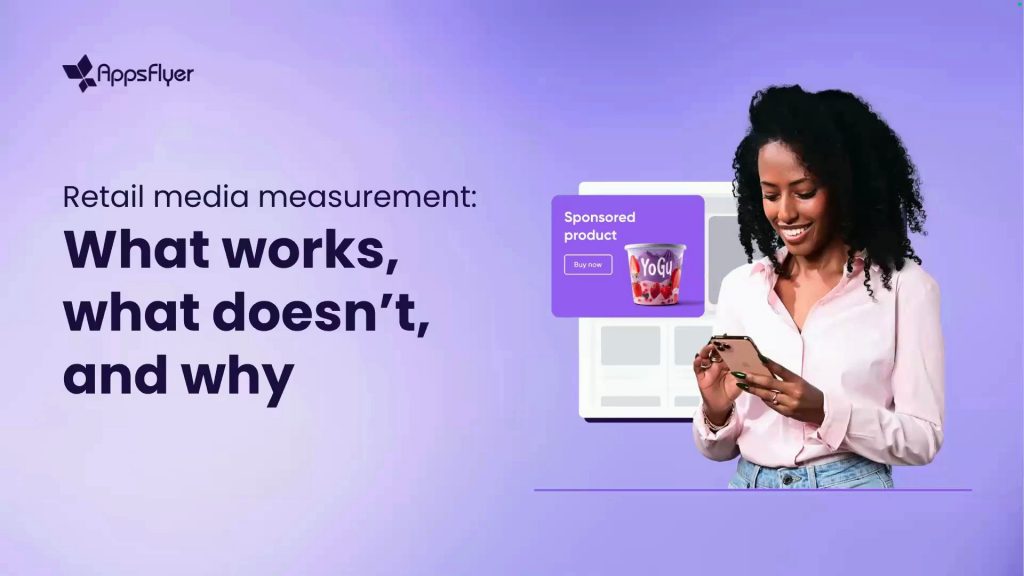
INTRODUCTION
How influencers fit into your app growth strategy
Influencer marketing has become one of the most powerful growth channels for mobile apps and games – and it’s only gaining momentum.
Beyond reach, influencers add a layer of authenticity that’s hard to achieve with traditional performance marketing. When a trusted creator shares your app, it doesn’t just drive installs – it builds trust, boosts brand recall, and lifts your results across the board.
For mobile marketers, influencers are more than a branding play – they’re a strategic lever for both user acquisition and retargeting.
In this guide, you’ll learn how to:
- Build an influencer strategy that supports your UA and retargeting efforts
- Budgeting wisely for your influencer campaigns
- Choosing the right creators to meet your goals
- Crafting and managing successful UA/retargeting campaigns with influencers
- Measuring valuable KPIs, and tying influencer impact to growth
Chapter 1
Budgeting smart for influencer marketing
If you’re new to influencer marketing, you’ll probably want to know: how much does this cost, and is it worth it?
Piecing together a budget depends on several factors – everything from your target audience to your daily organic installs and LTV – but here, we’ll help you calculate yours.
Step 1: Define your target markets
Get clear on who you’re targeting: their location, age, gender, and interests. Think about what types of content they consume. Again working from our cooking game example – don’t just look at cooking influencers. If your core audience is women 35+, you might find stronger results with lifestyle, wellness, or DIY creators. It all depends on their specific interests.
Each sub-segment could provide its own potentially lucrative returns. These sub-segments may fit vastly different influencers yet still share a common interest in the game.
Crafting comprehensive customer profiles will help you identify different opportunities and content verticals to tap into. Not sure of where to source this kind of information? Ask your users! Run surveys to gather data on the types of content and influencers they engage with so you know where to start. You can also look in-house: your business’ UA team will likely have a customer profile prepared.
Once you know who you’re reaching and which creators fit, you can estimate your media costs. A good starting point is CPM (cost per 1,000 views), which varies by audience.
Based on my experiences, a rough CPM benchmark to work from for English-speaking audiences on YouTube would be:
| Females 18+ y/o Minimum $30 | Females 35+ y/o Minimum $50 |
| Males 18+ y/o Minimum $20 | Males 35+ y/o Minimum $40 |
These numbers will help you set realistic expectations and avoid overspending on mismatched creators.
Step 2: Define your installs goal
In influencer marketing, a majority of conversions occur organically. So to reliably attribute any conversions to the influencer campaign, you need to be generating a visible uplift from the baseline daily organic installs (DOIs).Your Installs Goal, therefore, needs to be significantly higher than your baseline DOIs. A reliable benchmark to aim for is a 25% increase in your DOI:
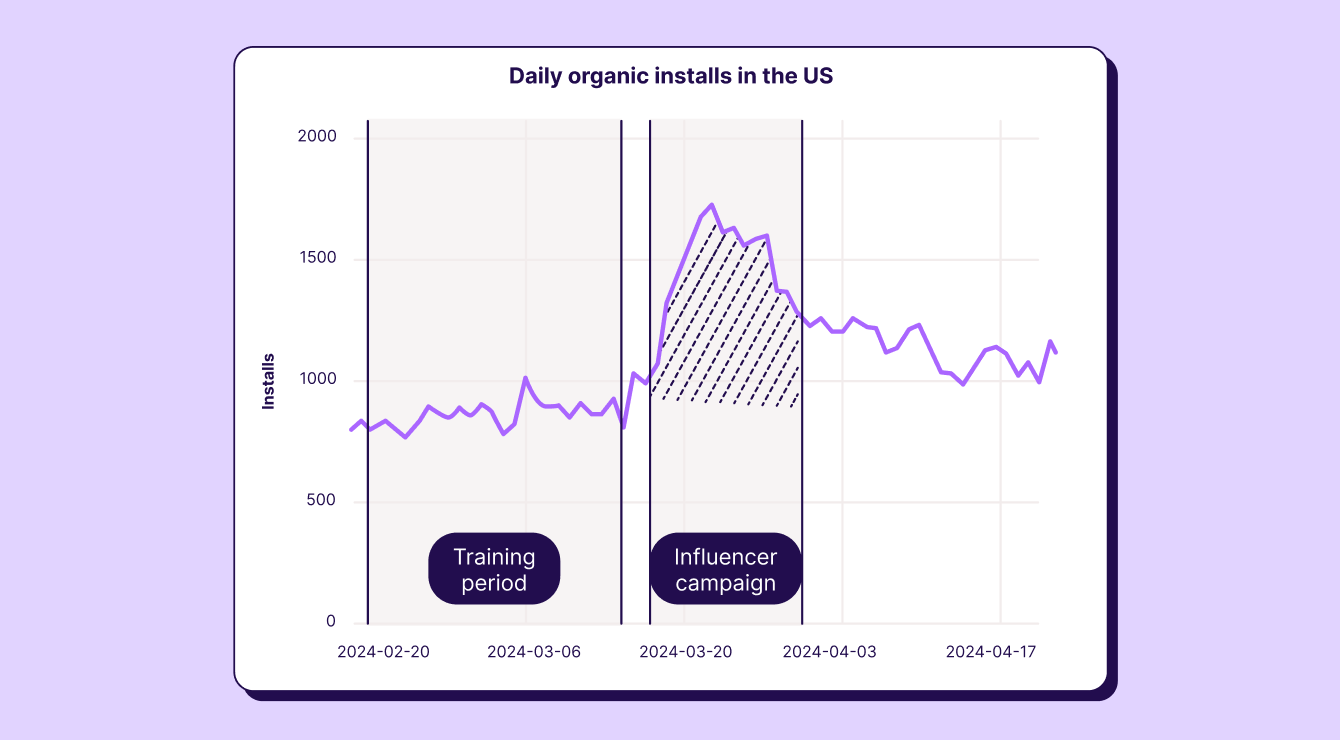
If your campaign runs for a week, then multiply your increased DOI target by 7 to get the minimum number of installs you need to produce over the campaign period.
Keep in mind that influencer marketing typically has a long tail. In my experience, around half of the views one year from publication will be made within the first 7 days.
Step 3: Calculate minimum required views & estimate performance
Every platform and influencer type comes with typical conversion rates – but actual performance can vary widely. That’s why scenario planning is key.
Map out three potential outcomes: Pessimistic, Medium, and Optimistic. Use industry benchmarks as your guide, and calculate expected installs for each.
Your goal: making sure even the Pessimistic outcome delivers enough installs to hit the goal you set in step 2.
Step 4: Calculate your budget
Using your target influence CPM (Step 1) and the minimum views needed to hit your Install Goal (Steps 2 and 3), you can easily calculate your recommended budget:

Setting the right budget is critical for optimizing your campaign’s outcome. Keep in mind there’s no one-size-fits-all “minimum budget” for influencer marketing. It varies greatly for different types of apps and brands, but following the above guidelines will ensure your campaigns are built on sturdy foundations.
Chapter 2
Finding the right influencers & channels
Having determined your budget, let’s now review four different options for exploring influencers. This all depends on your requirements and what resources you have at your disposal – from time and budgets to personnel. The main advantages and disadvantages of each option are:
| Manual Search | Self-Service Platforms | Multi-Channel Networks | Influencer Marketing Agencies | |
| Advantages | – No middleman =best price & direct communication line | – Hands-on from beginning to end – Access to 100K+ influencers – No hidden fees | – Best prices for the top influencers – Easier to do creative campaigns | – Access to a wide range of influencers – Can act as an extended part of your team |
| Disadvantages | – Extremely time-consuming – Can be a logistical challenge financially | Time-consuming to find contact, manage and sometimes even pay the influencers | Limited to the channels in their network | – It is important to find performance-driven agencies – Can have high commission fees |
Finally, whether you’re a small or large team, it can be worth bringing an influencer marketing consultant on board to add value and guidance and keep things strategically aligned.
Choosing the right influencer channel
The range and diversity of influencer platforms is continuously expanding, and navigating whether to invest in YouTube, Instagram, TikTok, Twitch, podcasts or others can be time-consuming.
Each platform presents its own strengths and weaknesses, which we dig into below – but it’s worth calling out YouTube specifically as a platform that often yields the best results:
| Platform | Strengths | Weaknesses | Best Use Cases |
| YouTube | – High-income, highly-engaged audience – Unskippable mid-rolls – Long shelf life | – Slower production – Higher creative lift | – Performance campaigns – Reviews & tutorials – Evergreen reach |
| – Great for reach & niche engagement – Visual storytelling | – Unpredictable results – Limited measurement | – Brand awareness – Trend-driven content | |
| TikTok | – Viral potential – Strong UGC repurposing | – Short content lifespan – Harder to predict reach | – Short-term spikes – Paid boosts & UGC |
| Twitch | – Super-engaged communities – Ideal for gameplay formats | – Weak fit for mobile – Hard to measure ROI | – PC/console gaming – Story-rich experiences |
| Podcasts | – Strong listener trust – Loyal, older audiences | – Harder to measure impact – Host-dependent | – Brandformance – Cross-platform lifts |
Which influencers are right for you?
Choosing the right influencers starts with one rule: trust the data, not your instincts. Personal preference is tempting, but performance lives in the numbers.
Here’s what to evaluate:
- Audience demographic data: Ensure the influencers you’re considering have audiences whose age, gender, and geographic distribution match that of your app’s target market.
- Recent average views: In the context of projections and fee calculations, it’s important to consider recent average views rather than lifetime average views.
- Content verticals: Consider content verticals that align closely with your product, brand, and audience.
- CPMs: Make sure your influencers’ price quotes are close to or below your target CPMs. If not, and the influencer is not open to negotiations, seek alternatives.
- Prior performance data: Prior performance of sponsored content can be a valuable indicator for if an influencer’s audience is receptive to ads and recommendations.
- Competitor activations: Repeat sponsorships with an influencer are a good indicator of a high-performing creator or vertical. You can use that starting point to find “lookalike” influencers with similar profiles.
- Content style and format: Analyzing the style of the influencer’s content can reveal whether this aligns with your own brand.
- Brand safety: It may be worth steering clear of any creators with overtly-political or religious leanings, or indeed recent negative press or controversies.
Chapter 3
Crafting and managing a campaign that delivers
Once you’ve selected your channels and secured agreements with the right influencers, it’s time to build the campaign itself. This chapter covers the essentials: defining deliverables, writing an effective brief, and structuring influencer compensation.
Setting essential deliverables
Deliverables are the foundation of a successful campaign. They ensure your influencers know exactly what’s expected and give you the best shot at hitting your KPIs.
While deliverables vary by platform, here’s a best-practice example for YouTube – a channel often ideal for engagement and conversion:
- 45–60 second integration
- Placement within the first 25% of the video
- Conversion link in the top line of the description
- Conversion link in a pinned comment
- QR code on screen during integration, linking to your landing page
These five deliverables ensure you’re optimizing your influencer collaboration for length, placement, and measureability.
Influencer compensation
Whether you’re working independently or with a network or agency partner, it’s important to know that you’re being quoted a fair price.
Subscribers, followers, or even “lifetime views” are vanity metrics. Never consider these when evaluating influencer rates, because they are rarely an accurate indicator of current content performance.
For video-based formats, the most important indicator is average views per video. Look at the average produced over the last 10-20 videos. Exclude any outliers, i.e. videos that diverge massively from the average. Check the frequency of posting.
Influencer payment terms
Influencers tend to favor flat-fee models: a flat price independent of performance, usually with an expectation that the content will not underperform the creator’s average.
Once you’ve calculated an influencer’s average views, use your target CPM to calculate how much you should be paying:

But what if you need to work with influencers who post infrequently or produce inconsistent views? Or if you have very strict performance targets? Performance-based Models can help mitigate the risks.
This model relies on variable pricing, typically based around a CPM and Performance Window (7d, 14d, 30d – 30d is the industry average). It often features a cap and sometimes a minimum guarantee.
The final price paid to the influencer depends on the number of views produced within the defined performance window:

This arrangement ensures that the CPM remains stable no matter how the video performs. It also provides the influencer with an opportunity to earn more than they would have on a flat-fee model. To that end, having a cap ensures you don’t need to pay above a certain fee in case the video goes viral.
Note that flat-fee models are the most commonly used by influencers who are in high demand.
Long-term partnerships
As is often the case for app marketing, building long-term partnerships will ultimately depend on the performance of the first collaboration.
If the integration performed poorly, and there is no clear route to optimization, then a long-term partnership is likely not worth pursuing.
In the case of good performance, you also need to be careful with oversaturation. Multiple videos with an influencer should be spread over time – eg, 2-3 months – with each one offering something exciting in order to be impactful.
Crafting an effective influencer brief
Once you’ve selected your influencers and negotiated their fees, you’ll need to provide a brief to create the video. While some influencers may already be experienced and proficient in creating effective content for brands, in general, your creative brief can make or break your campaign.
Remember three simple rules when writing your brief:
- Keep it short
- Get straight to the point
- Make it visually appealing
A good format to follow is to use a slide presentation that provides the following information:
- Video details (posting date, integration length & placement, campaign goal)
- Content requirements (play the game, CTA to download using the link, reminder at the end of the video)
- Talking points (e.g., the main features of the game)
- Resources (trailers, gameplays, logo, characters, fonts, key art)
- Do’s & Don’ts (Use your own words, avoid buzzwords etc). While experienced influencers will know to steer clear of the following topics, it can be worth advising them to avoid including any of these in your collaboration:
- Religion
- Politics
- Any form of discrimination
- Profanity
- Competitor products
- Known IPs
- Language with negative connotations, such as “addictive”
Ultimately, you want the influencers to be excited about the collaboration, and to understand your brand and the expectations you have.
At the same time, you need to avoid overwhelming them with information. Allow them, as creators, freedom to put their own spin on the content. Remember, they’ll likely know their own audience far better than you do.
Chapter 4
Measuring what matters
Now we turn to one of the most asked questions in influencer marketing: how to measure their effectiveness? Without that crucial bit of information, calculating ROI is virtually impossible.
Precise measurement is important not only at a campaign level, but at an individual creator level. It’s only when we can attribute installs, engagement, and revenue directly to campaigns that we can calculate ROI. It allows us to understand the platform’s true potential, and identify touchpoints to optimize and areas to scale.
Since a majority of influencer marketing conversions occur organically, accurate and granular data collection of the limited traffic that you can measure is vital to understanding and attributing organic traffic. It’s the only way to get the full picture of your influencer campaigns.
Measuring success without compromising experience
In influencer marketing, measurement is everything – but it shouldn’t come at the cost of the user experience. You want to track impact across platforms, devices, and user journeys, without creating friction for the influencer or their audience. That’s where smart linking solutions come into play.
AppsFlyer’s OneLink makes it easy to strike that balance. It simplifies measurement and attribution while delivering a seamless experience for users. Whether someone clicks a link in an Instagram Story, scans a QR code from a YouTube video, or swipes up from TikTok, OneLink ensures they’re taken straight to the right destination – in the app, if it’s already installed, or to the app store and then back to the intended content with deferred deep linking.
No dead ends, no clunky redirects, and no lost context.
This not only improves conversion rates, it also reflects well on your brand and the influencer – helping ensure smooth, consistent experiences that keep users engaged and attribution data intact.
How do I know if my influencer campaign is performing well?
It’s important to remember that no two apps will see identical results with influencer marketing. Everything including app genre, target audience, target geo, period and seasonality of the campaign, budget, incentive offerings, and creative strategy will have an impact on performance.
Metrics like CVR and CPM tend to have standard benchmarks within the influencer marketing industry, although they rely on the influencers themselves reporting impressions so that you can calculate the CPM. It’s also important not to compare these against the results you see on your other traditional UA channels.
By contrast, ROI and Retention Rate standards and targets vary greatly across apps, so there’s no benchmark to evaluate against. You could, however, analyze these KPIs in comparison to your own results across other UA channels. In 2024, we saw owned and earned media campaigns generate significantly higher conversion rates than paid marketing.
What’s more important to understand when evaluating your campaign is how your results stand against your own target KPIs and ROI benchmarks for other channels – rather than how they stack up against industry standards.
Finally, it’s critical that you don’t evaluate your influencer marketing based purely on one single campaign. It’s rare to reach profitability immediately. Industry benchmarks are a solid place to start, but it’s your initial campaigns that will serve as a true knowledge-gathering phase. As you scale towards greater success, your own past campaign data will provide the most accurate and reliable benchmarks.
Granular measurement made easy
Influencer marketing success hinges on the ability to track what’s working – and what’s not – down to the finest detail. With AppsFlyer’s OneLink, you can create fully customizable, measurable links for each individual influencer, campaign, and channel. This level of granularity means you can compare performance across creators, platforms, content types, and even agency partners – all while capturing meaningful post-install behavior.
Want to track by campaign name, media source, link placement, or influencer handle? You can do just that and also dive deeper with custom parameters, so you can measure whatever matters most to your strategy.
These insights empower you to double down on what works, refine what doesn’t, and prove ROI with precision.
Turning clicks into conversions
OneLink isn’t just about where users land – it’s about what they do next. By taking users directly to specific in-app content, OneLink helps deliver on the promise of the influencer’s post – whether that’s a limited-time offer, a new product, or a special reward.
This is especially impactful for incentive-based campaigns, where timing and context are everything. Whether a user is claiming in-game items, unlocking a discount, or exploring featured content, OneLink ensures they get where they need to go – even if they install the app first.
The result? Lower drop-off rates, faster time-to-value, and stronger downstream engagement.
Best practices for building your attribution links for influencer campaigns
Precise measurement starts with link building. That’s why it’s critical to follow best practices when it comes to structuring and creating links with defined parameters. This helps ensure you’re collecting data at a granular level, attributing it accurately, and making it easy to analyze campaign performance.
As an example of how this would look:
A shopping app is launching a New Year’s giveaway campaign in partnership with influencer Shoparella. She’ll promote it on her YouTube channel, with the giveaway link featured in the video description and as a QR code on-screen. The campaign is managed by the agency InfluPlan.
Below is a structured mapping of the campaign parameters and values used for measurement. Use this reference to align your data points with AppsFlyer’s attribution parameters and unlock accurate, granular reporting across your influencer campaigns:
| Campaign element | Example value | AppsFlyer parameter name | Raw URL parameter |
| Media Source | Influencers | Media Source | pid |
| Campaign Name | NewYearsResolution | Campaign Name | c |
| Ad Set (Influencer) | Shoparella | Ad Set | af_adset |
| Ad Name (Ad Type) | NewYearGiveaway | Ad | af_ad |
| Channel | YouTube | Channel | af_channel |
| Link Location | VideoDescription | Sub Param 1 | af_sub1 |
| Campaign Owner | InfluPlan | Custom Parameter | campaignowner (custom) |
The deep links themselves can be generated in two ways: manually, using OneLink’s UI to create individual measurement links, or bulk link creation using a flexible CSV file. The second method is useful for larger campaigns as it allows quick link deployment across multiple influencers and platforms. It ensures efficient link generation that can measure performance at a more granular level.
The example below shows how this setup appears within the AppsFlyer platform when generating your attribution link. Follow these steps to apply the correct structure:
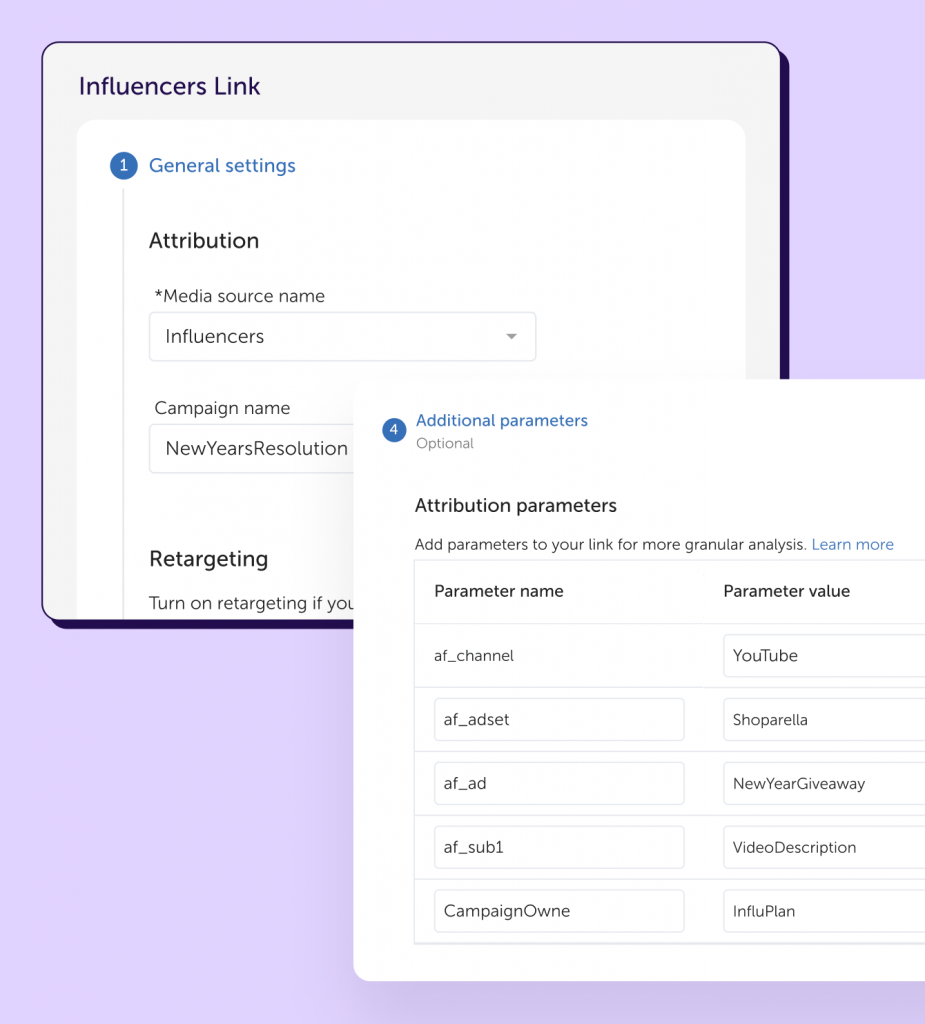
Measuring campaign performance and optimizing with the AppsFlyer dashboard
Once your links are live and the campaign has run its course, it’s time to dive into performance analysis. This is where AppsFlyer’s dashboards come into play – they offer multiple ways to interpret your data depending on the level of insight you need.
With the Marketing Overview, you can get an immediate snapshot of performance. This aggregated view surfaces key metrics such as installs, in-app events, and conversion rates across campaigns, influencers, and channels. It also allows you to benchmark influencer-driven activity against other UA and retargeting efforts, giving you a clear picture of contribution and impact.
A common trend among AppsFlyer users is customizing dashboards by team or function. Whether it’s Affiliates, PPC, or Lifecycle Marketing, each team can build views tailored to their own activity without overlap or confusion.Influencer marketing teams are increasingly adopting this approach, creating dedicated dashboards to analyze influencer performance independently. This allows them to compare performance across channels, measure activity by influencer, measure results over time, and identify top-performing content types.
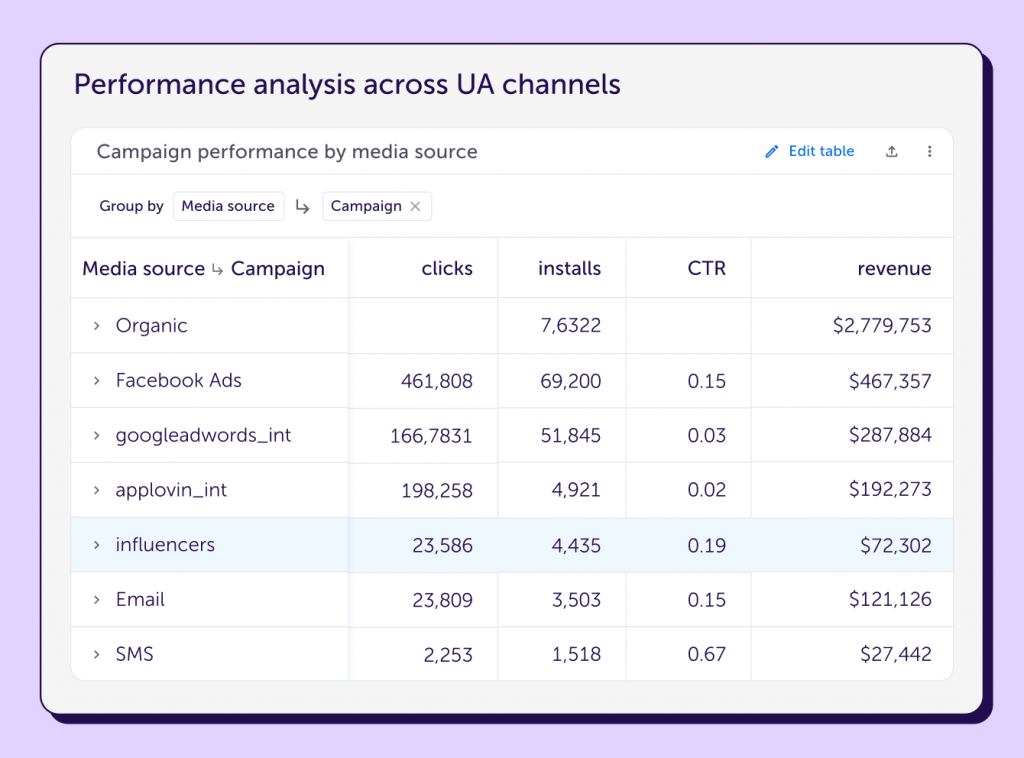
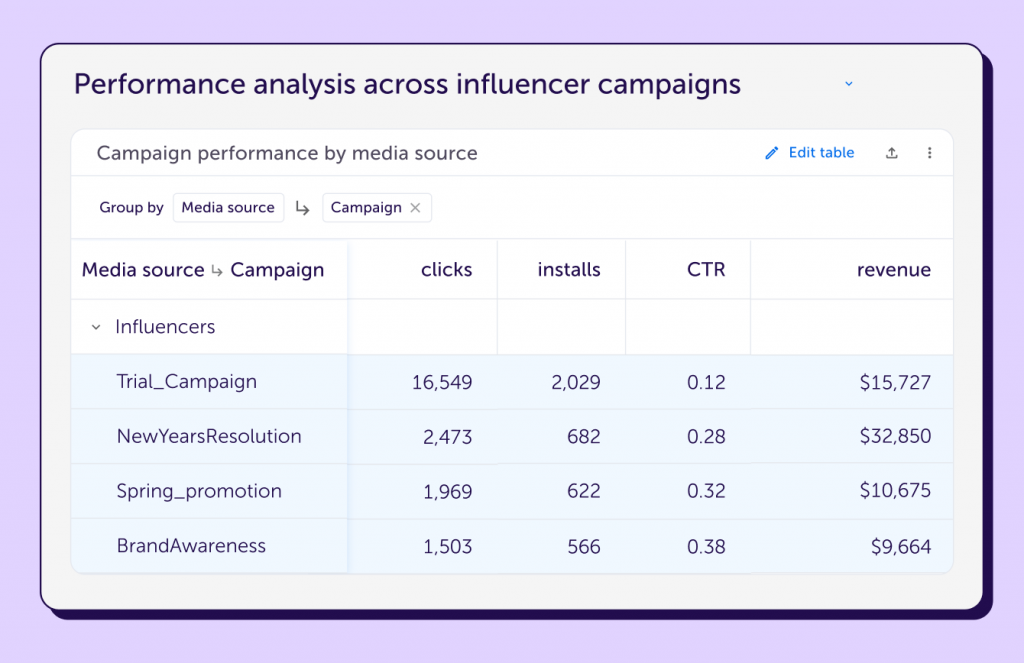
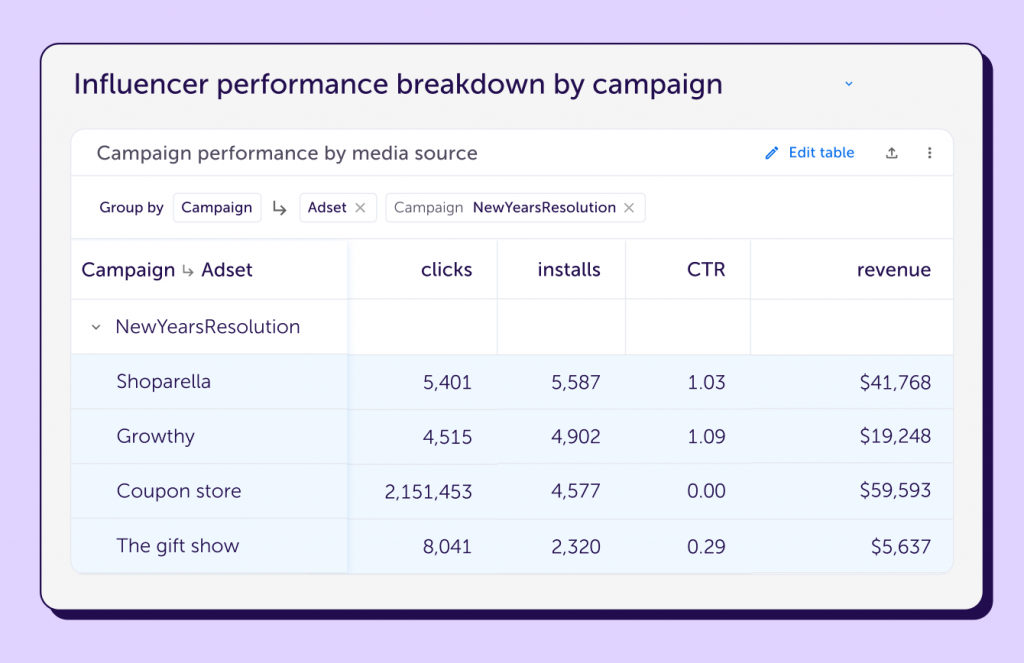
Chapter 5
Influencer marketing dos & don’ts: A handy guide
We’ve gone through a lot of best practices and advice for starting out and optimizing your influencer marketing strategy, so to wrap up, here’s a top-level overview of the basic Dos and Don’ts. Follow our guide and get ready to turn influencer marketing into a high-performing channel for your brand.
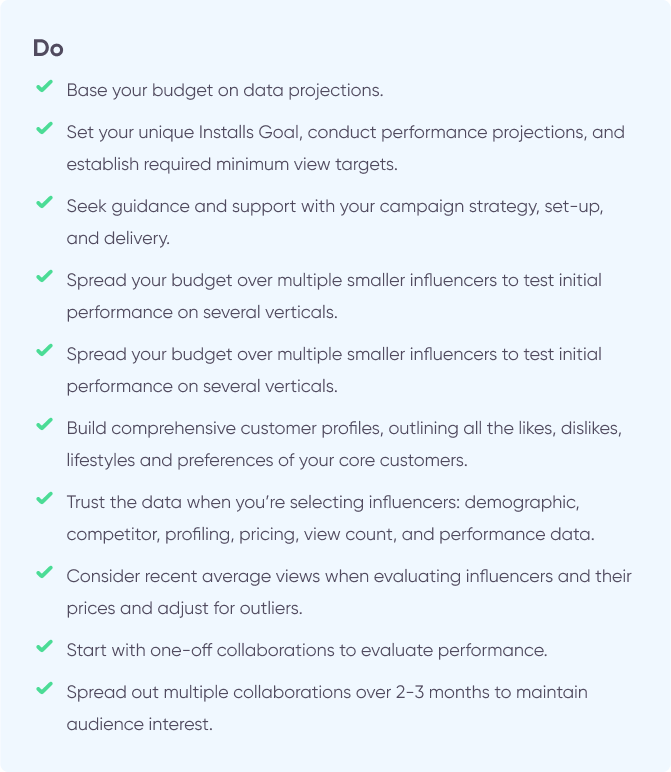

About the author
With over a decade in influencer marketing- six out of them in mobile gaming, Marion Balinoff helps companies turn influencers into scalable, performance-driven UA channels. She’s worked across genres and audiences and now consults top app and gaming companies to test, refine, and scale their strategies.





